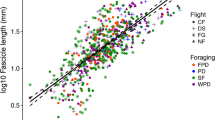Abstract
To gain insight into the mechanism of coordination of stepping in the fore and hind legs of quadrupeds, we examined the kinematics of leg movements and the motor patterns in fore and hind leg flexor muscles in decerebrate walking cats when the two pairs of legs stepped on separate treadmills running at different speeds. When the front treadmill was slowed progressively from 0.6 to 0.3 m/s with the rear treadmill running at 0.6 m/s, the rate of stepping in both the fore and hind legs decreased and a 1:1 stepping ratio was maintained. The decrease in the rate of stepping in the hind legs was due primarily to an increase in the duration of the swing phase. Slowing the speed of the rear treadmill while keeping the front treadmill speed at 0.6 m/s decreased the rate of stepping of the hind legs, but had relatively little influence on the average rate of stepping in the forelegs. In this situation stepping in the fore and hind legs was uncoupled and the time of stepping in one hind leg relative to the ipsilateral foreleg progressively shifted during a walking sequence. Analysis of the timing of electromyographic (EMG) recordings from flexor muscles of the hip and elbow joints yielded insight into the neuronal mechanisms underlying the asymmetry in slowing either the front or rear treadmill. We propose that ipsilateral pattern generating networks are asymmetrically coupled via descending inhibitory pathways and an ascending excitatory pathway. We discuss how the characteristics of these linkages are functionally appropriate for establishing the normal timing of stepping in the hind and forelegs during slow walking.












Similar content being viewed by others
References
Cang J, Friesen WO (2002) Model for intersegmental coordination of leech swimming: central and sensory mechanisms. J Neurophysiol 87:2760–2769
Cruse H (1990) What mechanisms coordinate leg movement in walking arthropods? Trends Neurosci 13:15–21
Cruse H, Warnecke H (1992) Coordination of the legs of a slow-walking cat. Exp Brain Res 89:147–156
English AW (1979) Interlimb coordination during stepping in the cat: an electromyographic analysis. J Neurophysiol 42:229–243
English AW (1985) Interlimb coordination during stepping in the cat: the role of the dorsal spinocerebellar tract. Exp Neurol 87:96–108
English AW, Lennard PR (1982) Interlimb coordination during stepping in the cat: in-phase stepping and gait transitions. Brain Res 245:353–364
Forssberg H, Grillner S, Halbertsma J, Rossignol S (1980) The locomotion of the low spinal cat. II. Interlimb coordination. Acta Physiol Scand 108:283–295
Halbertsma J (1983) The stride cycle of the cat: the modelling of locomotion by computerized analysis of automatic recordings. Acta Physiol Scand 521S:1–75
Hill AA, Masino MA, Calabrese RL (2003) Intersegmental coordination of rhythmic motor patterns. J Neurophysiol 90:531–538
Jezzuni SH, Hill AA, Kuzyk P, Calabrese RL (2004) Detailed model of intersegmental coordination in the timing network of the leech heartbeat central pattern generator. J Neurophysiol 91:958–977
Jones SR, Mulloney B, Kaper TJ, Kopell N (2003) Coordination of cellular pattern-generating circuits that control limb movements: the sources of stable differences in intersegmental phases. J Neurosci 23:3457–3468
Juvin L, Simmers J, Morin D (2005) Propriospinal circuitry underlying interlimb coordination in mammalian quadrupedal locomotion. J Neurosci 25:6025–6035
Kulagin AS, Shik ML (1970) Interaction of symmetrical limbs during controlled locomotion. Biophysics 15:171–178
Lam T, Pearson KG (2001) Proprioceptive modulation of hip flexor activity during the swing phase of locomotion in decerebrate cats. J Neurophysiol 86:1321–1332
Matsushima T, Grillner S (1992) Neural mechanisms of intersegmental coordination in lamprey: local excitability changes modify the phase coupling along the spinal cord. J Neurophysiol 67:373–388
McVea DA, Donelan JM, Tachibana A, Pearson KG (2005) A role for hip position in initiating the swing-to-stance transition in walking cats. J Neurophysiol 94:3497–3508
Miller S, Reitsma DJ, van der Meche FGA (1973) Functional organization of long ascending propriospinal pathways linking lumbo-sacral and cervical segments in the cat. Brain Res 62:169–188
Miller S, van der Burg J, van der Meche FGA (1975) Coordination of movements of the hindlimb and forelimb in different forms of locomotion in normal and decerebrate cats. Brain Res 91:217–237
Miller S, van der Meche FGA (1976) Coordinated stepping of all four limbs in the high spinal cat. Brain Res 109:395–398
Miller WL, Sigvardt KA (2000) Extent and role of multisegmental coupling in the Lamprey spinal locomotor pattern generator. J Neurophysiol 83:465–476
Orsal D, Cabelguen JM, Perret C (1990) Interlimb coordination during fictive locomotion in the thalamic cat. Exp Brain Res 82:536–546
Pearson KG, Iles JF (1973) Nervous mechanisms underlying intersegmental co-ordination of leg movements during walking in the cockroach. J Exp Biol 58:725–744
Skinner FK, Mulloney B (1998) Intersegmental coordination in invertebrates and vertebrates. Curr Opin Neurobiol 8:725–732
Stein RB, Misiaszek JE, Pearson KG (2000) Functional role of muscle reflexes for force generation in the decerebrate walking cat. J Physiol (Lond) 525:781–791
Tunstall MJ, Roberts A, Soffe SR (2005) Modelling inter-segmental coordination of neuronal oscillators: synaptic mechanisms for uni-directional coupling during swimming in Xenopus tadpoles. J Comput Neurosci 13:143–158
van der Meche FGA (1976) Locomotion in the cat. A behavioural and neurophysiological study of interlimb coordination. Thesis
Wetzel MC, Atwater AE, Wait JV, Stuart DG (1975) Neural implications of different profiles between treadmill and overground locomotion timings in cats. J Neurophysiol 38:492–501
Acknowledgments
We thank Rod Gramlich for constructing the split treadmill, and his expert technical assistance. Supported by funding from the Canadian Institutes of Health Research, Natural Science and Engineering Council of Canada, and the Alberta Heritage Foundation for Medical Research.
Author information
Authors and Affiliations
Corresponding author
Rights and permissions
About this article
Cite this article
Akay, T., McVea, D.A., Tachibana, A. et al. Coordination of fore and hind leg stepping in cats on a transversely-split treadmill. Exp Brain Res 175, 211–222 (2006). https://doi.org/10.1007/s00221-006-0542-3
Received:
Accepted:
Published:
Issue Date:
DOI: https://doi.org/10.1007/s00221-006-0542-3




